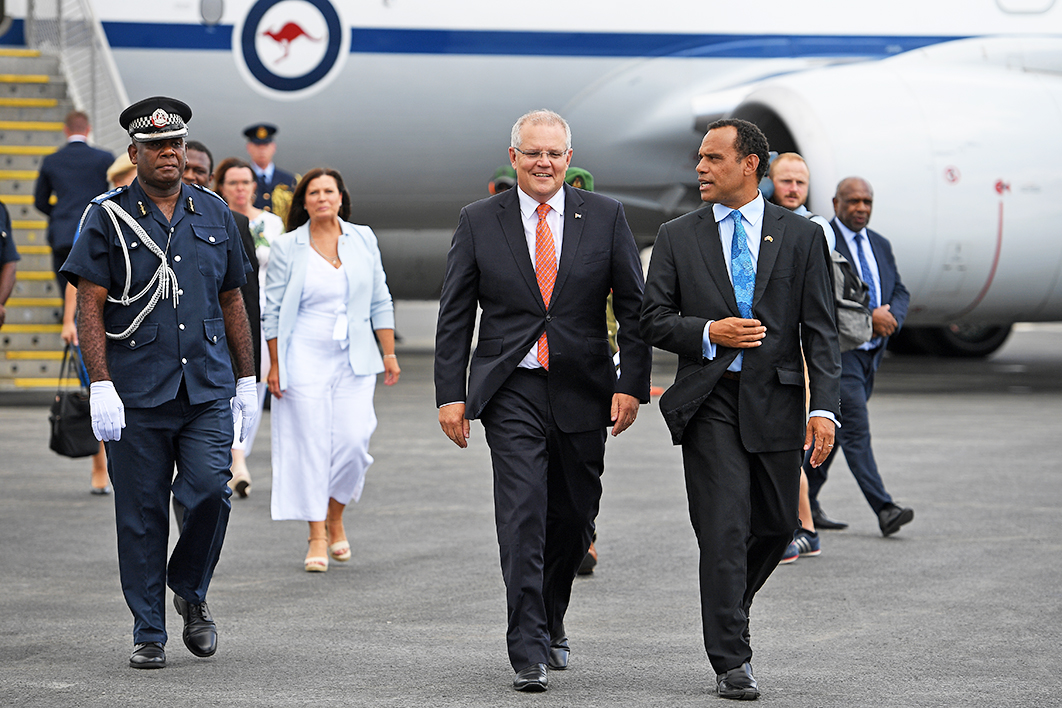Back in 2017 Samoan prime minister Tuilaepa Sailele Malielegaoi declared that geography and the shift in global power had combined to put the Pacific “at the centre of contemporary global geopolitics.” He was talking about the Blue Pacific, an initiative designed to create what he called “a new narrative for Pacific regionalism and how the [Pacific Islands] Forum engages with the world.”
Whether the region’s plan to take greater control of its fate will be squeezed or helped by the two much larger narratives rising up at its edges — the Washington-led Indo-Pacific partnerships and Beijing’s Belt and Road initiative — is largely up to the Pacific Islanders themselves. At least that’s the message from Pacific Islands Forum secretary-general Dame Meg Taylor and Vanuatu’s foreign minister Ralph Regenvanu.
The pair, whom I interviewed for the latest Little Red Podcast, believe that the Pacific is up for the challenge, though the two big-power narratives will need some tweaking to fit with the concerns and hopes of Pacific Islanders, particularly about climate change and jobs.
Awkwardly for the current US and Australian administrations, neither leader sees security for the Blue Pacific as a matter of building military bases on Manus Island or dealing with skulduggery around the Luganville Wharf. Climate change is the leading security concern, as Dame Meg explained.
“If you look at the Pacific Rim countries,” she said, “you’ve got to ask yourself, who is really committed to the one issue, the most important issue that faces this region: climate change? It’s not just the sea-level rise. Sea surges, tsunamis, cyclones. But you’ve also got drought, water. And it’s very, very real. It’s not as if a country [such as China] can come in and do something physical. What they have to do is make sure their emissions are down to 1.5 or even lower so that we can survive.”
Beyond resilience and survival come Pacific livelihoods. Here the hopes of the Pacific are clear: access to labour markets (including Australia’s, of course), training for Pacific youth, and meaningful opportunities after graduation. Here, China runs into a problem not so much with the Belt and Road narrative as with the reality on the ground created by its companies and its migrants.
Vanuatu’s foreign minister outlines the dilemma for Pacific leaders — they know pragmatically that nations can’t afford to forgo the roads, ports and hospitals built by Chinese aid. But the experience of many Pacific Islanders is that Chinese nationals, if not the Chinese government, are taking their jobs.
“There’s a lot of concern about the new retail shops being opened, all being controlled by Chinese and owned by Chinese,” says Regenvanu. “There’s lots of concerns about Chinese labourers being used on construction sites to do jobs that ni-Vanuatu feel they can do… There are high levels of unemployment, kids graduating who can’t find jobs. And you see people who you perceive as foreigners having jobs, having businesses. And you think, you’re a local and you can’t have that access. That obviously becomes a problem.”
Riots targeting Chinese shopkeepers have a long and less-than-glorious history in the Pacific, complicating the Belt and Road’s emphasis on people-to-people connections. Vanuatu’s neighbours — Papua New Guinea, Tonga and the Solomon Islands — have all seen serious violence directed at “new” Chinese communities.
As yet, Vanuatu has seen no hint of violence, but a rise in the number of Chinese nationals there — from 500 or so a decade ago to around 4000 today — has seen online rumblings. Discontented locals, whose views are reflected in Facebook groups such as Yumi Toktok Stret, divide the blame between the new arrivals and the government for failing to act.
A recent post, reacting to last year’s 60 Minutes episode The China Syndrome: Is China Taking Over the South Pacific?, contrasted China’s infrastructure loans with those of other countries, arguing the “main condition is ONLY Chinese engineering or construction companies are to be employ to do the Job. Blame your leaders not Chinese. Money istap lo China [the money stays in China].”
Ironically, the Chinese shopkeepers themselves put the sudden rise in Port Vila’s Chinese population down to migration from less-safe Pacific countries, as well as a growing middle-class group that has come to Vanuatu for health or lifestyle reasons. As one restaurant owner put it, “When I first arrived, I was shocked. I thought I’d been tricked. The airport was falling apart. The capital city doesn’t even have a set of traffic lights. But then I came to see how happy people were. When they smile, it’s not like people in China, they smile with their whole body.”
Vanuatu also holds appeal because of its proximity to Australia and New Zealand, offering the prospect of short, sharp periods of under-the-table work for Chinese nationals on tourist visas.
On the Indo-Pacific side, both sides of Australian politics are waking to the realisation that Pacific nations really do care about labour mobility, and that domestic politics may have to be put to one side.
One area where the Belt and Road appears to be stealing a march on the Indo-Pacific is the ramping up of scholarship and training opportunities. As Dame Meg explained, “We’ve raised this with other large powers that want to come back into the region about giving scholarships to our students. And the response I got was, ‘That’d be a really hard thing to sell right now.’ So there you are… they’re not prepared to really look at the needs of the region and our young people, then I’d be questioning, ‘Well why come back?’”
It’s a fair question. •




